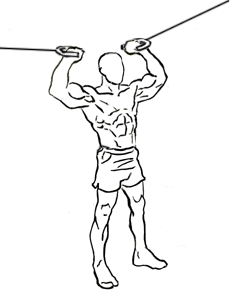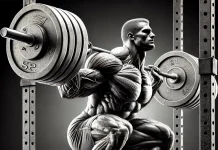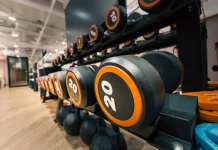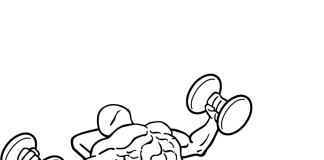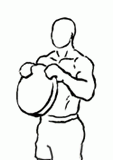Last Updated on September 25, 2014
The Overhead Cable Curl is a powerful exercise designed to isolate and build definition in the biceps muscles, making it ideal for anyone looking to achieve well-rounded arm strength and aesthetic appeal. Unlike traditional curls, the Overhead Cable Curl places the biceps under constant tension due to the cable resistance, maximizing muscle engagement and providing a unique challenge for upper body workouts.
In this comprehensive guide, we’ll cover everything from proper technique and benefits to advanced variations, helping you fully leverage this exercise for optimal bicep growth and definition. Let’s dive into the details to master the Overhead Cable Curl and make it a staple in your arm training regimen.
Why the Overhead Cable Curl?
The Overhead Cable Curl is a highly effective exercise for a few key reasons:
- Enhanced Muscle Isolation: This exercise allows you to specifically target the biceps by isolating them from surrounding muscle groups, helping build defined, toned arms.
- Continuous Tension: Using a cable machine keeps the biceps under continuous tension throughout the movement, providing a more intense workout compared to free weights.
- Unique Angle: The overhead angle targets the biceps from a different position, which helps engage the bicep’s long head and adds variety to your arm workout.
- Improves Symmetry: By working both arms independently, the Overhead Cable Curl helps correct any muscular imbalances between the right and left arms.
- Perfect for Muscle Definition: This exercise is excellent for shaping and defining the biceps, making it popular for those aiming to improve upper arm aesthetics.
Anatomy of the Biceps
Before diving into the exercise, it’s essential to understand the structure of the biceps muscles. The biceps brachii is a two-headed muscle that runs along the front of the upper arm and plays a critical role in elbow flexion and forearm rotation. Here are the two main parts:
- Long Head: Located on the outer side of the arm, the long head is responsible for the peak of the biceps and is often activated in exercises that involve a stretch in the shoulder joint, such as the Overhead Cable Curl.
- Short Head: Positioned on the inner side of the arm, the short head adds width and thickness to the biceps. It’s engaged during exercises where the arms are closer to the body, but also plays a role in the overhead position of this exercise.
The Overhead Cable Curl effectively engages both heads, with a particular emphasis on the long head due to the extended arm position, helping create balanced and fully developed biceps.
Step-by-Step Guide: How to Perform the Overhead Cable Curl
Equipment Needed: A cable machine with two high pulleys and stirrup handles.
1. Setting Up
- Attach the Handles: Start by attaching a stirrup handle to each side of a high pulley on a cable machine. Adjust the height so that the handles are at shoulder level or slightly above when you grasp them.
- Stand in Position: Stand in the center of the machine with your feet shoulder-width apart. Grasp each handle with an underhand (supinated) grip, ensuring your palms are facing up.
2. Starting Position
- Extend Your Arms: Fully extend your arms to the sides, parallel to the floor, creating a “T” shape with your body. This is your starting position.
- Stabilize Your Core: Engage your core to keep your torso stable and prevent any swaying. Keep your shoulders down and back to maintain proper posture.
- Feet Position: Ensure your feet are firmly planted and your knees are slightly bent for stability.
3. Execution
- Curl the Handles: Keeping your elbows steady and fixed at shoulder level, curl the handles towards your head by contracting your biceps. The motion should be similar to bringing your wrists to the sides of your head.
- Focus on the Biceps: As you curl, focus on squeezing the biceps and avoid using momentum or swinging the arms.
- Peak Contraction: Pause briefly at the peak of the movement with the biceps fully contracted, holding the position to maximize muscle tension.
4. Return to Starting Position
- Lower with Control: Slowly extend your arms back to the starting position, maintaining control and tension in the biceps.
- Avoid Relaxing: Don’t let the weights pull your arms back abruptly. Maintain tension and control throughout the descent.
5. Repeat
- Aim for 10-15 repetitions per set, performing 3-4 sets to fully work the biceps and achieve a good pump.
Tips for Maximizing Your Overhead Cable Curl
- Keep Elbows Steady: Lock your elbows in place to prevent shoulder involvement and ensure the biceps are fully engaged.
- Focus on Form: Move through the entire range of motion with a slow, controlled pace, focusing on contracting the biceps at the peak.
- Avoid Using Excessive Weight: This exercise is about control and isolation, so start with moderate weights that allow you to maintain form.
- Engage Your Core: Stabilizing your core can help prevent swaying, ensuring your body remains steady.
- Breathe Correctly: Exhale as you curl the handles toward your head and inhale as you extend your arms back to the starting position.
Common Mistakes to Avoid in the Overhead Cable Curl
To get the most out of the Overhead Cable Curl, be mindful of these common mistakes:
- Allowing the Elbows to Drop: Letting your elbows drift below shoulder height reduces tension on the biceps. Keep your elbows steady at shoulder level throughout.
- Using Momentum: Avoid swinging the arms or using your body to lift the weight. Rely on controlled movements to engage the biceps fully.
- Overextending the Wrists: Keep your wrists straight and avoid bending them backward or forward, which can strain the wrists.
- Neglecting Core Engagement: Without engaging the core, you may sway, which compromises form and reduces bicep activation.
- Rushing the Movement: This exercise requires a slow, controlled pace to keep tension on the biceps. Avoid rushing, which reduces the effectiveness of the movement.
Benefits of the Overhead Cable Curl
- Enhanced Bicep Definition: This exercise provides a unique angle that helps carve out well-defined biceps, especially targeting the long head.
- Improved Arm Symmetry: Working both arms independently promotes balanced development and symmetry.
- Continuous Tension for Muscle Growth: Cable resistance creates continuous tension, which is ideal for muscle hypertrophy and sculpting.
- Reduced Joint Strain: Unlike free weights, cables offer a smoother range of motion, reducing strain on the joints.
- Versatile and Accessible: The Overhead Cable Curl can be easily modified to suit different fitness levels and is accessible in most gyms with a cable machine.
Variations of the Overhead Cable Curl
Adding variations to your routine can prevent plateaus and keep your workouts fresh. Here are some effective variations:
- Single-Arm Overhead Cable Curl:
- Perform the exercise with one arm at a time. This helps address imbalances and enhances mind-muscle connection, allowing you to focus on each bicep individually.
- Seated Overhead Cable Curl:
- Perform the exercise seated on a bench with the cables adjusted to shoulder height. This removes lower body stabilization, allowing you to focus solely on the biceps.
- Rope Overhead Cable Curl:
- Attach a rope handle to the high pulley and perform the curl with both hands. The rope attachment allows a greater range of motion and engages more muscle fibers.
- Incline Dumbbell Curl:
- Although it doesn’t use cables, the incline dumbbell curl provides a similar stretch on the biceps and can be a useful alternative if a cable machine isn’t available.
- Standing Low Cable Curl:
- Set the pulley at a low position and perform curls from the bottom. This targets the biceps differently but also allows for continuous tension in the arm muscles.
Integrating the Overhead Cable Curl into Your Workout Routine
The Overhead Cable Curl is best used as part of your arm day or upper body workout. Here’s a sample routine:
- Warm-Up:
- Start with 5-10 minutes of light cardio followed by dynamic stretches for the shoulders and arms.
- Sample Arm Workout:
- Barbell Curls: 4 sets of 8-10 reps for mass building.
- Hammer Curls: 3 sets of 10 reps to target the brachialis and forearms.
- Overhead Cable Curl: 3 sets of 12-15 reps for bicep isolation and definition.
- Tricep Pushdowns: 4 sets of 10 reps to focus on triceps.
- Cable Face Pulls: 3 sets of 12 reps to target rear delts and upper back.
- Cool-Down:
- Finish with static stretching focused on the biceps and triceps to promote flexibility and recovery.
Adjustments for Different Fitness Levels
- Beginners:
- Start with lighter weights and focus on mastering form. Aim for 2-3 sets of 15 reps for endurance and control.
- Intermediate:
- Increase the weight slightly, performing 3 sets of 12 reps. Try adding a brief pause at the peak of the movement for more intensity.
- Advanced:
- Use heavier weights and perform 4 sets of 10-12 reps. Consider incorporating supersets or drop sets to challenge the biceps further.
Benefits of the Overhead Cable Curl for Athletes and Bodybuilders
Athletes and bodybuilders can benefit greatly from the Overhead Cable Curl:
- Improved Arm Definition: This exercise helps build well-defined biceps, contributing to the visual appeal of the arms.
- Enhanced Upper Body Strength: Strong biceps support various pulling and lifting movements in sports and weightlifting.
- Balanced Arm Development: Training both arms individually ensures balanced strength, preventing one side from becoming dominant.
Final Thoughts on the Overhead Cable Curl
The Overhead Cable Curl is a valuable addition to any arm-focused workout, providing continuous tension, muscle isolation, and a unique angle to target the biceps. With proper form and controlled movements, this exercise can effectively build and define the biceps, helping you achieve a more symmetrical and aesthetically pleasing upper body.
By incorporating this exercise into your routine, you can improve not only the appearance of your arms but also functional strength for various lifting and sports movements. Make the Overhead Cable Curl a regular part of your workouts, and enjoy the benefits of sculpted, powerful biceps.

